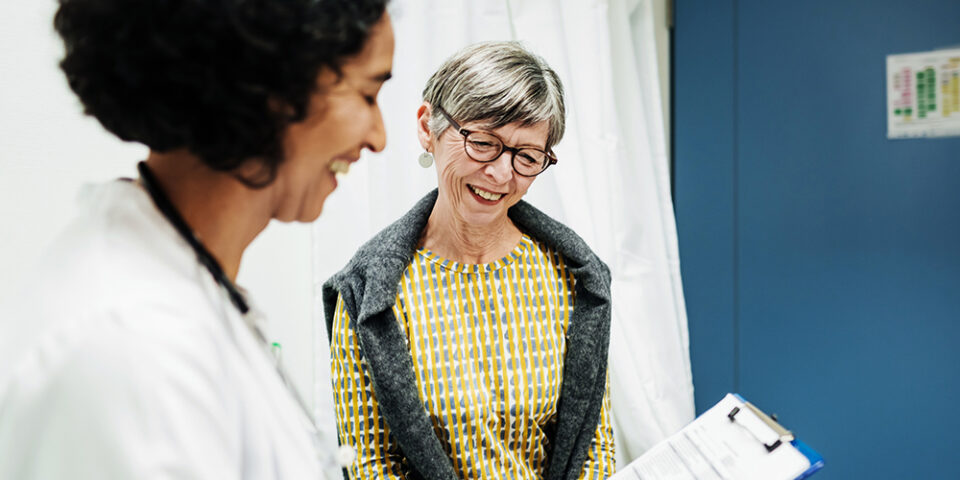Preventing osteoporosis and protecting your bones after menopause
If you’re menopausal, you’ve probably already experienced the joy of hot flashes and night sweats. But there might be a menopause symptom you haven’t noticed: bone loss. OB/GYN Jonathan Bailey, MD, explained why bone loss, and osteoporosis in particular, is a concern during menopause.
Why is menopause connected to osteoporosis?
Most of your bone mass is built by the time you reach your early 30s, and then it starts to decline.
“It’s like someone takes a little chunk out of your brick wall every few years,” Dr. Bailey said, “and the pace of that chipping away speeds up with menopause.”
The reason? Estrogen protects against bone loss, but as estrogen declines during menopause, your chances of osteoporosis go up. Osteoporosis is a bone disorder resulting in weaker bones and an increased risk of fractures.
“Osteoporosis is very common and it’s a silent medical problem,” Dr. Bailey said. “You’re not usually going to have any symptoms until you have a fracture.”
About 1 in 6 women aged 50–60 (and 1 in 3 by age 80) will experience a fracture in their lifetime. A fracture to the spine or hip can happen from a simple fall and be extremely painful, impacting a person’s life significantly.
“Fractures in your lower back can change your posture and your gait,” Dr. Bailey said. “After a hip fracture, about 25% of women will need long term care. It’s a sad statistic, but 20% of women will not be alive a year after a hip fracture. So, it’s important we don’t wait until someone has a fracture to address osteoporosis.”
How can osteoporosis be prevented?
Osteoporosis and osteopenia can be prevented through screening and treatment. A bone density scan (also called a DEXA scan) is recommended at age 65 to identify if you have osteoporosis.
“We will sometimes start them as early as age 60, or earlier, if somebody has significant risk factors,” Dr. Bailey said. “We take the numbers from the DEXA scan and put them into an algorithm that gives you a 10-year risk of fracture. And based on what your 10-year risk of fracture is, we’ll talk to you about therapy options.”
In addition to menopause, you can be more at risk for osteoporosis if you:
- Have low body weight (less than 126 pounds) and are naturally thin.
- Have a first degree relative, such as your mother, with osteoporosis.
- Smoke or use tobacco products.
- Take certain medications like aromatase inhibitors or steroids.
- Have certain health conditions, like autoimmune disorders, that affect your bones.
To make sure you’re protecting your bone health, it’s important to discuss it with your doctor during the first signs of menopause. To reduce your risk of fractures, hormone replacement therapy might be recommended, as well as taking calcium and vitamin D supplements.
“It seems that almost none of us are getting enough vitamin D,” Dr. Bailey said. “I recommend people get at least 1000 international units a day, and even up to 2000 a day is fine. It’s really important for bone health, but it’s also important for other hormonal activity.”
He also recommended taking a 500 milligram calcium supplement every day.
“People tend to get a decent amount of calcium in their diet even if they don’t each much dairy, and so you don’t normally need to give yourself a ton extra,” he said.
What treatment options are available for bone loss?
There are monthly treatment options, as well as once-a-year options – even injectables for people with more significant osteoporosis.
“The way bone develops is you have certain cells that build bone and certain cells that break down bone, and they balance each other out to help keep your bones strong,” Dr. Bailey said. “Our earliest osteoporosis drugs inhibited the cells that break down bone, so the cells that build bone can have a little bit of a head start.”
Those are called antiresorptive agents and include drugs like Fosamax and Boniva. They can be given weekly, monthly or even as yearly injection.
“We will usually use those for five or six years and then take a drug holiday,” Dr. Bailey said. “We found out that they do tend to build bone strength initially, but over the long haul, if you use them too long, consecutively, you can start building bone that’s somewhat fragile.”
After a couple of years, a DEXA scan is usually used to gauge whether bone density is holding steady.
“If density starts dropping again, we can restart the drug, or we can start something that’s not an antiresorptive agent,” Dr. Bailey said.
Forteo and Prolia are drugs that help stimulate bone growth.
“There are several different drugs available now,” Dr. Bailey said, “but they’re not usually our first line treatment for osteoporosis. We use it for severe osteoporosis and for people who can’t take the antiresorptive agents like Fosamax.”
The bottom line about osteoporosis after menopause
Remember, you can’t feel if bone loss is happening, so it’s important to talk to your doctor when you start noticing other menopause symptoms and discuss your bone loss prevention plan.
Learn more about bone loss prevention by listening to this podcast.
Choose a caring, trusted OB/GYN
Find a provider who’s right for you by viewing their online profiles, star ratings and reviews.
Find an OB/GYN

